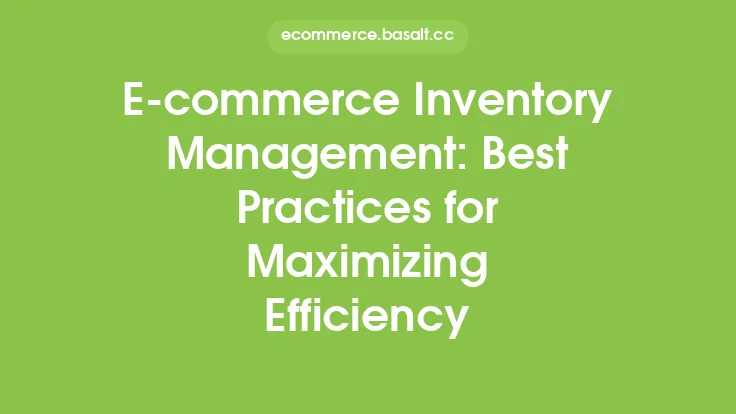Implementing a Product Information Management (PIM) system is a significant undertaking for any e-commerce business, requiring careful planning, execution, and ongoing maintenance. A well-implemented PIM system can have a transformative impact on a company's operations, enabling them to manage product information more efficiently, improve data quality, and enhance customer experience. However, a poorly implemented system can lead to frustration, wasted resources, and missed opportunities. In this article, we will explore the best practices for implementing a PIM system, providing guidance on how to ensure a successful rollout and maximize the benefits of this powerful technology.
Planning and Preparation
Before embarking on a PIM implementation project, it is essential to lay the groundwork for success. This involves defining the project's scope, goals, and objectives, as well as identifying the key stakeholders and their roles. A thorough analysis of the company's current product information management processes, data quality, and system landscape is also necessary. This will help to identify areas for improvement, potential roadblocks, and opportunities for integration with existing systems. Additionally, it is crucial to establish a clear understanding of the company's product information requirements, including the types of data to be managed, the channels through which it will be distributed, and the level of granularity required.
Data Governance and Quality
Data governance and quality are critical components of a successful PIM implementation. A well-defined data governance framework is necessary to ensure that product information is accurate, complete, and consistent across all channels. This involves establishing clear policies and procedures for data creation, update, and validation, as well as defining the roles and responsibilities of data owners and stewards. Data quality is also essential, as it directly impacts the customer experience and the effectiveness of the PIM system. Implementing data validation rules, data normalization, and data enrichment processes can help to ensure that product information is accurate and consistent.
System Selection and Configuration
Selecting the right PIM system is a critical decision, as it will have a significant impact on the success of the implementation project. When evaluating PIM systems, it is essential to consider factors such as scalability, flexibility, and ease of use, as well as the level of support and training provided by the vendor. Once a system has been selected, it is necessary to configure it to meet the company's specific needs and requirements. This involves setting up data models, workflows, and user roles, as well as integrating the PIM system with other systems, such as e-commerce platforms, ERP systems, and CRM systems.
Integration and Interoperability
Integration and interoperability are key considerations when implementing a PIM system. The PIM system must be able to integrate with other systems, such as e-commerce platforms, ERP systems, and CRM systems, to ensure that product information is consistent and up-to-date across all channels. This involves establishing APIs, data feeds, and other integration points to enable the exchange of data between systems. Additionally, the PIM system must be able to support multiple data formats and protocols, such as XML, JSON, and CSV, to ensure seamless integration with other systems.
Change Management and Training
Implementing a PIM system requires significant changes to business processes and workflows, which can be challenging for employees to adapt to. Effective change management and training are essential to ensure a smooth transition and minimize disruption to the business. This involves providing comprehensive training to employees on the use of the PIM system, as well as communicating the benefits and value of the system to stakeholders. Additionally, it is necessary to establish a support process to address questions and issues that may arise during the implementation and post-implementation phases.
Monitoring and Maintenance
After the PIM system has been implemented, it is essential to monitor its performance and maintain it to ensure that it continues to meet the company's evolving needs. This involves tracking key performance indicators, such as data quality, system uptime, and user adoption, as well as conducting regular system updates and maintenance tasks. Additionally, it is necessary to continuously review and refine the PIM system to ensure that it remains aligned with the company's strategic objectives and continues to deliver value to the business.
Scalability and Flexibility
A PIM system must be scalable and flexible to accommodate the company's growing needs and evolving product information requirements. This involves selecting a system that can handle increasing volumes of data and user traffic, as well as adapting to changes in the company's product offerings, channels, and markets. Additionally, the PIM system must be able to support multiple languages, currencies, and regions to enable the company to expand its global reach and competitiveness.
Security and Compliance
Security and compliance are critical considerations when implementing a PIM system, as product information is a valuable asset that must be protected from unauthorized access and misuse. This involves implementing robust security measures, such as access controls, encryption, and authentication, to ensure that product information is secure and compliant with relevant regulations and standards. Additionally, the PIM system must be able to support compliance with industry-specific regulations, such as GDPR and CCPA, to ensure that the company remains compliant and avoids potential fines and penalties.
Conclusion
Implementing a PIM system is a complex and challenging project that requires careful planning, execution, and ongoing maintenance. By following best practices, such as planning and preparation, data governance and quality, system selection and configuration, integration and interoperability, change management and training, monitoring and maintenance, scalability and flexibility, and security and compliance, companies can ensure a successful rollout and maximize the benefits of this powerful technology. A well-implemented PIM system can have a transformative impact on a company's operations, enabling them to manage product information more efficiently, improve data quality, and enhance customer experience.





